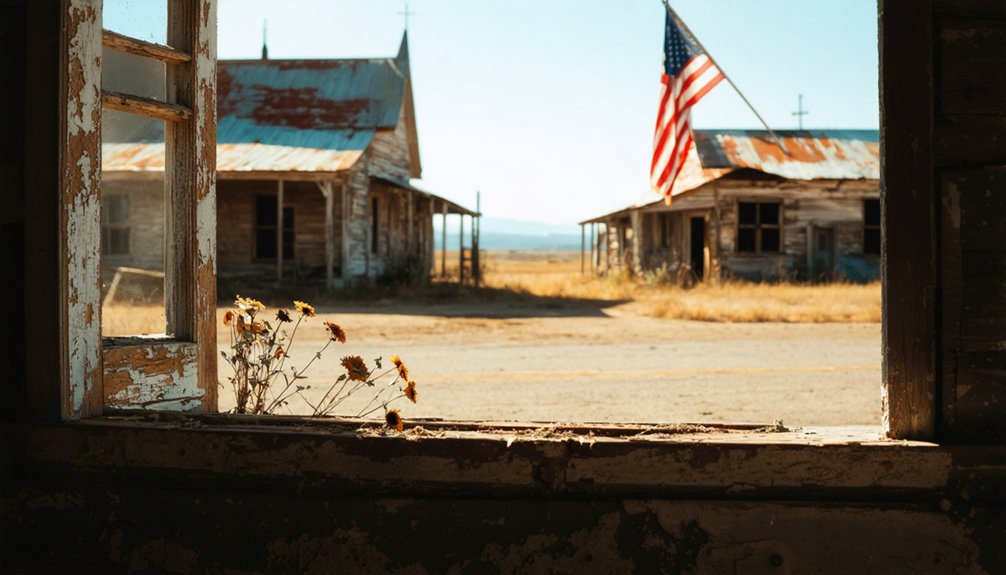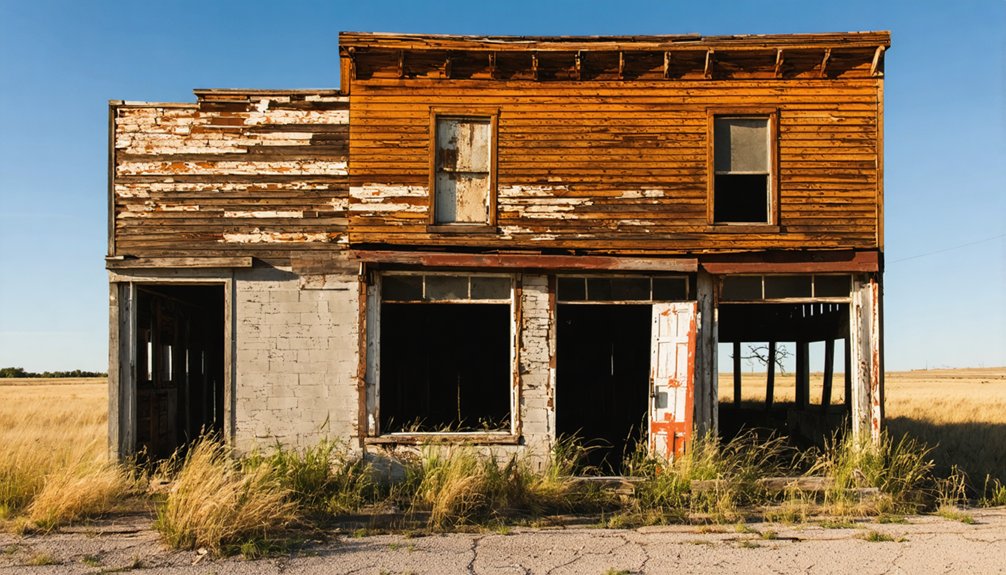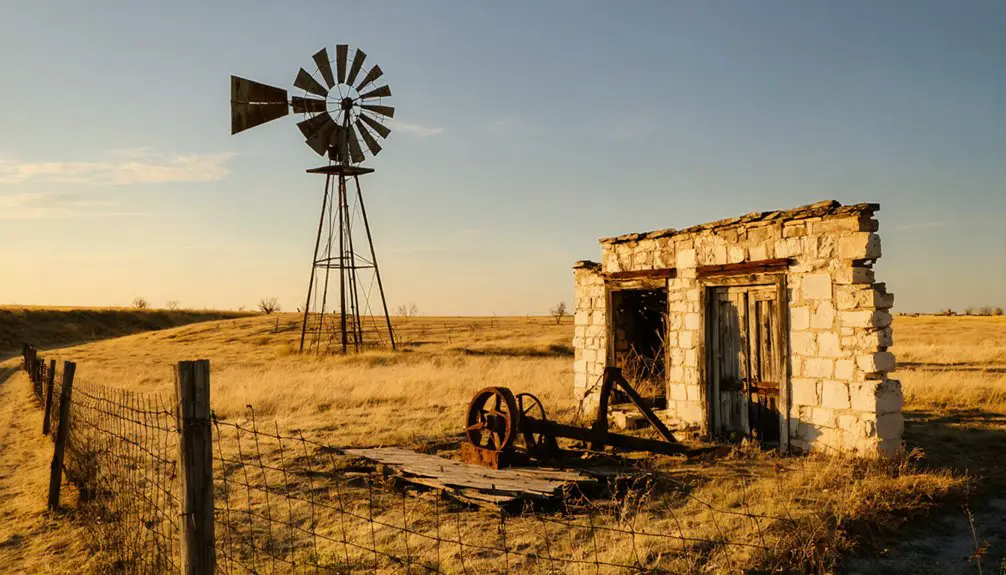You’ll find the ghost town of Hale in Oklahoma’s Osage County, where William King Hale built his criminal empire during the 1920s oil boom. His 5,000-acre ranch and banking operations dominated the region until his orchestration of the Osage murders was exposed. After Hale’s conviction in 1929, fear and economic decline caused families to abandon the area. Today, the weathered remnants tell a dark tale of greed, corruption, and justice in the American West.
Key Takeaways
- Hale, Oklahoma became a ghost town following William King Hale’s criminal empire and the notorious Osage murders of the 1920s.
- The town’s decline accelerated after Hale’s 1929 conviction, with many families relocating due to fear and broken community trust.
- Economic deterioration followed as oil operations slowed and local businesses closed, leading to widespread abandonment of the area.
- Local folklore and ghost stories about the abandoned town center around the dark legacy of Hale’s crimes against the Osage.
- The ghost town now serves as a historical reminder of the intersection between oil wealth, corruption, and the Osage murder conspiracy.
The Rise of a Ranching Community
As the Civil War drew to a close, ranching emerged as the dominant economic force in the Oklahoma Territory, including the area that would become Hale.
Ranching transformed Oklahoma Territory’s economy after the Civil War, shaping communities like Hale through livestock and land development.
You’ll find that ranching techniques evolved as both Native American tribes and settlers established operations near major cattle trails like the Chisholm and Western. The territory expansion brought significant cultural integration as the Five Tribes developed profitable enterprises, adapting traditional livestock management methods with settler practices. The Cherokee Nation’s impressive growth to a quarter-million cattle by 1861 demonstrated the region’s ranching potential. Grazing and leasing fees provided substantial income for tribal nations during this period.
The economic shift intensified when the Cherokee Outlet opened to cattlemen in the early 1880s.
Ranching families like the Allees exemplified the historical significance of these developments, creating lasting legacies through community development.
The Discovery of Oil and Osage Wealth
While ranching shaped Hale’s early development, the discovery of oil on Osage lands in 1895 marked a transformative economic shift for the region. The initial oil discovery, secured through Henry Foster’s blanket lease, faced early challenges with transportation and fluctuating prices. The Indian Territory Illuminating Oil company emerged as a key player in development.
You’ll find that everything changed when pipeline construction in 1904 slashed transport costs by 40%, releasing unprecedented Osage wealth. By the 1920s, the Lo, the Rich Indian headlines filled newspapers nationwide as Osage wealth generated white resentment.
- Osage leaders masterfully negotiated terms preserving their mineral rights control
- The headright system guaranteed equal distribution of oil royalties to tribal members
- Pipeline infrastructure transformed modest production into massive wealth
- The tribe’s economic power grew as oil production surpassed 5 million barrels by 1907
This newfound prosperity brought both opportunity and challenge, as outsiders increasingly sought access to the valuable mineral rights through marriage and other means.
William King Hale’s Dark Empire
You’ll find William King Hale‘s rise to power began with his arrival in Osage County around 1900, where he quickly built a criminal empire through the manipulation of oil headrights and local law enforcement.
Prior to his Oklahoma crimes, Hale worked as a Texas cowboy in his youth, learning the skills that would later help him manage his ranching empire.
As a reserve deputy sheriff, Hale orchestrated murders of Osage tribe members while cultivating relationships with influential Oklahoma politicians to protect his interests.
His ruthless control over the region left an indelible mark on Oklahoma history, leading to one of the FBI’s earliest major investigations and exposing the systematic exploitation of Native American wealth. His criminal enterprise flourished as he owned a 5,000-acre ranch and dominated the local banking industry.
Power Through Oil Rights
The immense wealth of Oklahoma’s oil fields set the stage for William King Hale’s dark empire in Osage County during the early 1920s.
You’ll find that oil wealth from Osage headrights created powerful economic incentives for control, with annual royalties exceeding $10 million at their peak. Hale recognized this opportunity, positioning himself as the “King of the Osage Hills” through his calculated settlement in the region around 1900. Over 60 mysterious murders occurred as Hale’s influence grew throughout the county. His nephew Ernest Burkhart’s marriage to Mollie was a calculated move to gain control of her family’s wealth.
- Controlled half a million dollars annually through manipulated headright ownership
- Leveraged oil profits to build a network of banks and businesses
- Orchestrated murders to redirect inheritance of valuable oil rights
- Exploited legal loopholes allowing non-Osage individuals to inherit headrights
Through this systematic exploitation of oil rights, Hale transformed his cattle ranching business into a vast criminal enterprise that dominated local power structures until federal intervention.
Manipulation of Law Enforcement
Since establishing his empire in Osage County, William King Hale masterfully manipulated local law enforcement through an intricate web of corruption, bribery, and intimidation.
You’ll find his influence reached deep into the county’s police force, where he strategically controlled investigations through threats and payoffs. His intimidation tactics guaranteed officers remained silent or actively helped cover up the murders of Osage victims. The investigations were severely hampered by W.V. Vaughan’s obstacles, including widespread corruption among officials. Private detectives hired to investigate the murders were often found to be criminal collaborators themselves.
Law enforcement corruption under Hale’s grip was extensive. He’d plant false leads to confuse investigators and delay justice, while his network of compromised officials helped shield him from prosecution.
When cases did proceed, he’d exploit jurisdictional complexities between state and federal courts, often maneuvering trials to state courts where his influence was strongest. Local residents, fearing retaliation, wouldn’t cooperate with authorities, further cementing Hale’s control.
Legacy of Criminal Control
William King Hale’s grip on law enforcement marked only one facet of his expansive criminal empire, which grew to dominate every aspect of Osage County life by the 1910s.
Through systematic criminal exploitation, he built an economic stronghold using:
- Control of Fairfax Bank to manipulate financial transactions
- Strategic cattle ranching operations to establish legitimate business cover
- Extensive moneylending schemes targeting vulnerable Osage landowners
- A network of corrupt officials and hired killers to maintain power
You can still feel the weight of his systemic oppression today. Known as the “King of the Osage Hills,” Hale orchestrated over 20 murders during the “Reign of Terror,” using violence and intimidation to seize oil wealth from Osage headright holders.
Though his 1929 conviction ended the immediate threat, the dark legacy of his criminal control forever changed Oklahoma’s landscape.
The Reign of Terror Unfolds

You’ll discover that Hale, Oklahoma became ground zero for a criminal enterprise in the 1920s when William Hale orchestrated a series of murders targeting wealthy Osage tribal members.
Through carefully planned assassinations, including the killings of Henry Roan and Anna Brown, Hale’s organization systematically eliminated Osage individuals to seize their oil rights and inheritance.
The murders sent shockwaves through the nation, eventually drawing the FBI into one of its first major homicide investigations and exposing a vast conspiracy of local power players who’d exploited the Osage people’s wealth.
Criminal Masterminds Take Control
During the early 1920s, a sinister figure named William King Hale transformed Hale, Oklahoma into the epicenter of a calculated murder-for-profit scheme targeting Osage Native Americans.
Through complex criminal networks and power struggles, he orchestrated a reign of terror that would forever change the region’s destiny.
You’d witness Hale’s ruthless control through:
- A vast network of accomplices, including his nephew Ernest Burkhart and corrupt lawyers
- Strategic manipulation of legal systems to avoid federal jurisdiction
- Sophisticated murder plots involving shootings, bombings, and kidnappings
- Elaborate financial schemes targeting Osage oil wealth through insurance fraud
Hale’s criminal enterprise operated with calculated precision, using indirect methods to maintain plausible deniability while amassing wealth through violence.
His influence extended deep into local institutions, allowing his reign to continue unchallenged for years.
Osage Murders Shock Nation
The shocking scale of violence against the Osage people emerged in the early 1920s, as mysterious deaths and murders terrorized Oklahoma’s oil-rich tribal territory.
You’ll find that between 1920 and 1925, over 60 Osage headright holders died under suspicious circumstances, though recent research suggests hundreds may have perished. The murders targeted wealthy Osage individuals who owned valuable mineral royalties from tribal oil lands.
Despite attempts to silence witnesses and derail investigations, Osage resilience prevailed.
When Anna Brown’s murder sparked outrage, the Osage Tribal Council demanded federal intervention in 1923. Their determination led to the exposure of William K. Hale‘s murderous conspiracy.
Through community healing and persistence, the Osage helped establish one of the Bureau of Investigation’s first major homicide cases, forever changing federal crime-fighting authority.
Federal Investigation and Justice
After violence and mysterious deaths plagued the Osage community, tribal leaders formally petitioned the U.S. Bureau of Investigation for federal oversight.
The FBI deployed four undercover agents who infiltrated the Osage Hills community using innovative investigative methods after previous private detectives failed.
- William Hale, known as “King of the Osage Hills,” emerged as the primary suspect
- Physical evidence included a blood-stained towel, matching ballistics, and DNA
- Ernest Burkhart, Hale’s nephew, broke under interrogation and testified against him
- Federal authorities recovered all ransom money during Hale’s high-speed chase arrest
Though the Department of Justice preferred federal jurisdiction, state courts ultimately tried Hale’s case.
After multiple trials exposing corruption and bribery schemes targeting Osage oil wealth, Hale was convicted in 1929 and imprisoned at Leavenworth Penitentiary.
Life After the Murders

Following William Hale’s conviction in 1929, life in Osage Hills underwent dramatic changes as residents grappled with the murders’ aftermath.
You’d have witnessed the town’s social fabric unraveling as fear and suspicion took hold, causing many families to relocate. Community healing proved challenging as both Native and non-Native residents struggled with deep psychological wounds and broken trust.
The economic impact hit hard too. You’d have seen oil operations slow down, businesses close, and jobs disappear.
Trust rebuilding seemed nearly impossible, as the betrayal by local white leaders left lasting scars. While the murders sparked important legal reforms and increased FBI presence, they’ve left an indelible mark on Oklahoma’s history.
Today, you’ll find Hale’s remaining structures standing as silent witnesses to this dark chapter.
The Town’s Gradual Decline
While Hale’s economy initially thrived on local agriculture and natural resources, you’d have seen the town’s decline accelerate through multiple compounding factors in the early 20th century.
The economic shifts that impacted Hale followed patterns common to many Oklahoma ghost towns, where changing transportation routes and agricultural mechanization diminished the town’s viability.
Key community changes that sealed Hale’s fate:
- Young residents departed for better opportunities in larger cities
- Local businesses closed as population dwindled by over 80%
- Schools and churches shuttered, breaking down social bonds
- Transportation changes reduced the town’s accessibility and commerce
The transformation from a bustling agricultural community to a ghost town reflected broader rural decline patterns, as modernization and urbanization drew people away from small farming towns.
Physical Remnants Today

Today in Hale, you’ll find a haunting collection of deteriorating structures that tell the story of this Oklahoma ghost town’s past. The abandoned structures include weathered motel buildings, empty service stations, and boarded-up homes with broken windows.
Rusty business signs still cling to walls, creating an eerie atmosphere that feels frozen in time. As you explore the site, you’ll discover concrete foundations, rubble piles, and overgrown streets that hint at the town’s former layout.
While no public buildings remain standing, the architectural elements from the early-to-mid 20th century persist in their decay. The surrounding land has largely returned to nature, with vegetation creeping through abandoned structures.
Unlike other Oklahoma ghost towns, Hale shows no signs of industrial contamination, just the quiet testimony of time’s passage.
Legacy in Popular Culture
The story of William K. Hale and the Osage murders has become a significant part of Oklahoma’s cultural representation through various media.
You’ll find his notorious legacy depicted in Martin Scorsese’s “Killers of the Flower Moon,” which was filmed in Osage County’s historic locations.
The tale’s historical narratives have spread beyond local boundaries through:
Dark chapters of history ripple outward, their stories crossing borders through countless retellings and cultural remembrances.
- True crime articles documenting his reign as the “Osage King of Crime”
- Academic research and publications examining the societal impact on Native communities
- Folk stories and oral histories preserving the dark chapter of regional heritage
- Ghost town lore connecting abandoned settlements to the aftermath of his crimes
The cinematic adaptation has revived public interest in this complex story, where greed, power, and injustice intersected in early 20th century Oklahoma, forever changing the cultural landscape of Osage County.
Preserving Historical Memory
Preserving historical memory in Hale’s ghost town relies heavily on thorough documentation and community involvement.
You’ll find historical documentation efforts include extensive architectural surveys, aerial photography, and detailed records that capture the town’s physical features and changes over time. Community storytelling plays an essential role, as former residents and their descendants contribute oral histories that enrich the historical record.
Local stewardship groups maintain and share information through social media platforms and heritage tourism initiatives. You can access these stories through published books, informational websites, and museum exhibits that detail the town’s decline.
While challenges like weathering and limited funding threaten preservation efforts, modern technology such as drone photography helps document current conditions and raises awareness about this important piece of Oklahoma’s history.
Frequently Asked Questions
What Is the Current Population of Hale, Oklahoma?
You won’t find ghost stories without people to tell them – Hale’s current population is effectively zero, as this historically significant town now stands abandoned like many Oklahoma ghost towns.
Are There Any Guided Tours Available of Historical Sites in Hale?
You won’t find official guided tours of this ghost town. While the site holds historical significance, no organized tours currently operate. You’re free to explore independently, following proper access protocols.
Can Visitors Legally Explore the Remaining Structures in Hale?
You can’t legally explore or conduct ghost hunting in Hale’s structures without property owner permission. Urban exploration here risks trespassing charges since buildings are likely on private land.
How Accessible Is Hale by Public Transportation Today?
You won’t find any public transport options to this ghost town. Its accessibility is extremely limited – you’ll need your own vehicle since there’s no bus service or public transit infrastructure.
Are There Any Annual Commemorative Events Held in Hale?
Drawing a blank here – there aren’t any known annual commemorative events in Hale. Despite Oklahoma’s rich ghost town history, Hale’s been left out in the cold when it comes to organized celebrations.
References
- https://en.wikipedia.org/wiki/William_King_Hale
- https://en.wikipedia.org/wiki/List_of_ghost_towns_in_Oklahoma
- https://ualr.edu/sequoyah/thisday/hale-given-life-sentence-february-1-1929/
- https://www.youtube.com/watch?v=-jYN1_E2VV0
- https://www.okhistory.org/publications/enc/entry?entry=GH002
- https://www.okhistory.org/publications/enc/entry?entry=CA077
- https://www.okhistory.org/learn/cowhands4
- http://resources.swco.ttu.edu/reference/bibliographies/ranching.php
- https://www.youtube.com/watch?v=DCuIhx4gULg
- https://en.wikipedia.org/wiki/United_States_v._Ramsey_(1926)



